July 2, 2024: Protesters brave rain, warning
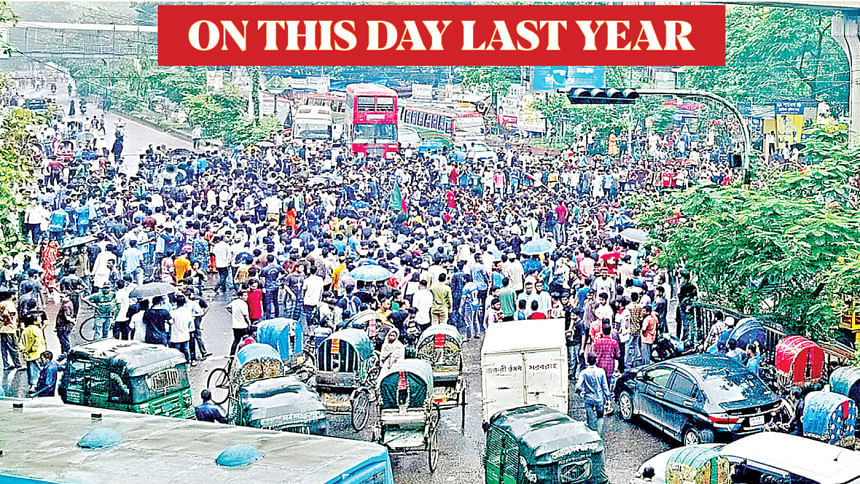
Defying rain, warnings, and exhaustion, the anti-quota protests gained momentum for the second consecutive day as hundreds of students and job seekers poured into the streets of Dhaka on July 2. Carrying the energy of the previous day's mobilisation, demonstrators continued their demand to reinstate the 2018 circular that had abolished quotas in government jobs -- a circular recently nullified by a High Court verdict.
The day's protests were part of a three-day nationwide programme declared a day earlier by the Boishomybirodhi Chhatra Andolon (Students Against Discrimination), which was spearheading the agitation. The programme began around 2:45pm with a large rally from the Dhaka University Library premises. The procession moved through Nilkhet, Science Laboratory, and Bata Signal, finally arriving at Shahbagh intersection.
There, demonstrators occupied the streets, blocking traffic and chanting slogans such as "Quota na medha, medha medha" (Merit, not quota) and "Boishomyer biruddhe, direct action" (Direct action against discrimination). By the time they reached Shahbagh, a heavy police presence had already taken position. Students, undeterred, shouted "Bhua bhua" (fake, fake) at the law enforcement agency. No clash occurred, and the police eventually stepped aside.
"This movement is not just about students or job seekers -- it's about the kind of state we want to build," said Nahid Islam, coordinator of the movement, addressing the gathering. "The spirit of the Liberation War is not a hereditary privilege; it is a national ideal. We, the youth, are upholding that spirit by standing against discrimination."
He announced that the protests would continue the next day with a sit-in at 2:30pm in front of the Dhaka University library and urged students across all universities and colleges in the country to join the movement simultaneously under a united banner.
For nearly an hour, the protesters held their ground at Shahbagh before lifting the blockade around 4:45 pm. From there, they marched towards the vice chancellor's residence of Dhaka University, where they demanded the reopening of the university library, which had remained shut for two days. Teachers, officials, and staffers of public universities have been abstaining from work since July 1 in protest against the government's Universal Pension Scheme, prolonging the stalemate in the activities of higher educational institutions across the country.
While Dhaka University became the epicentre of the day's protests, similar demonstrations unfolded across other campuses as well. At Jahangirnagar University, a group of students blocked the Dhaka-Aricha highway around 3:00pm, demanding the cancellation of the reinstated quota system along with three other demands. The blockade lasted for about 20 minutes and resulted in a two-kilometre traffic snarl in both directions. Earlier, the students had held a protest rally from the base of the Shangshaptak sculpture near the university's central library.
The protesters had also announced plans to enforce a two-hour highway blockade again on July 3, from 3:00pm to 5:00pm—further intensifying the spread of the movement beyond the capital.
Students from Barishal University, Jagannath University, Chittagong University, and Islamic University in Kushtia also organised processions and rallies, occupying campus roads and entry points.
Earlier in the day, around 10:30am, members of the pro-government organisation Bangladesh Muktijoddha Sontan Sangsad gathered in front of the Raju Sculpture at Dhaka University, opposing the anti-quota protests and advocating for the preservation of the 30 percent quota for children of freedom fighters.
By its second day, the anti-quota protest showed no signs of slowing down. With swelling participation, coordinated action, and a powerful moral claim, the movement was rapidly transforming into a nationwide youth uprising -- challenging not just a single policy but the deeply rooted structures of privilege and inequality.

 For all latest news, follow The Daily Star's Google News channel.
For all latest news, follow The Daily Star's Google News channel. 

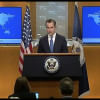
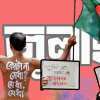
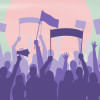

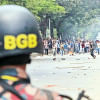

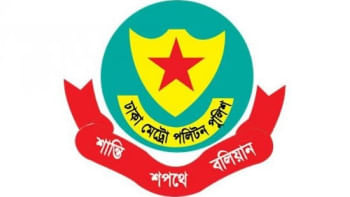
Comments